Is Shopify better than Square? If you are considering to choose the best ecommerce platform to build your own online store, both Shopify and Square are worth investing. To choose the most suitable one for maximizing revenue and meet your needs & budget, let’s have a look at this comparison between Shopify vs Square before deciding.
Contents
- 1 A Quick Comparison of Shopify vs Square
- 2 Compare Square vs Shopify Fees & Payments
- 3 Shopify vs Square: Ease of use
- 4 Shopify vs Square: Key Features
- 5 Shopify vs Square: Integrations & Add-Ons
- 6 Shopify vs Square: SEO & Marketing tools
- 7 Shopify vs Square: Help and Support
- 8 Shopify vs Square: which one is better?
A Quick Comparison of Shopify vs Square
Shopify is well known in the eCommerce industry as one of the easiest to use integrated storage platforms. Using Shopify, shop owners can quickly create themselves a professional, clean, and fully responsive website without any programming knowledge. Besides, the store templates are excellent and are specifically optimized for high conversion rates, and the servers and infrastructure have been designed with e-commerce in mind. This means your load times, payment integrations, customization capabilities, and even analytics are all excellently combined, ensuring you have everything you need to run a great online store.
Square (formerly SquareUp) was launched in 2009, with the idea of a smart operation system for phones with no monthly and set-up fee. Square’s main product set includes Square Register and Square Point of Sale (POS). Square also recently released Square Online Checkout, which makes a payment more flexible for selling an item, making a donation, or offering subscriptions. Up to now, it has extended its platform to facilitate merchants who expand their businesses to the web. Square Online Store is a great eCommerce platform for any new entrant in the online sales space. Their easy-to-navigate platform can be integrated into any major website in minutes – and it’s easy to sell content using the main platform when you get started.
Compare Shopify vs Square Table:
|
Shopify |
Square |
|---|---|
|
– Require a monthly subscription fee |
– Free to use with processing fee |
|
– Shopify transaction fees start at 2.9% + $0.30 online and 2.7% in-person |
– Square transaction fees are 2.9% + $0.30 online and 2.6% + $0.10 in-person |
|
– Has a well-featured POS system |
– Square’s POS ecosystem is robust, and has more industry-specific apps and features than Shopify |
|
– Has a large ecosystem of 3rd party apps |
– Has a smaller tightly controlled universe of integrations |
|
– Suitable for most industries and company size |
– Not suitable for high-risk industries and high-volume merchants |
|
– Has 24/7 customer support |
– Not have 24/7 customer support |
Compare Square vs Shopify Fees & Payments
Shopify

Shopify offers three e-commerce level plans. Each higher price tier offers additional features and lower payment processing fees. You can upgrade your plan at any time as your business grows.
All plans include hosting, SSL certificates for secure payments as well as an unlimited number of products, storage, and bandwidth. POS (Point of Sale) option Shopify for direct selling is available for a surcharge and will integrate with any plan.
When using a third-party payment gateway for credit card processing, Shopify charges a percentage-based transaction fee for each order. This rate is highest in the lowest price plan and decreases as the package increases. If you use Shopify Payment, there are no transaction fees on any of the plans.
- Basic Shopify: $25/month
- Shopify plan: $65 a month
- Advanced Shopify: $399 per month
DISCOVER NOW: Shopify Pricing Plans
Square
Square Online offers one free plan, along with three premium plans. But how are they different and which one gives the best value?
Here’s a quick overview of Square Online’s monthly prices and transaction fees for each plan:
|
Plan |
Monthly cost |
Monthly cost (billed annually) |
Transaction fee |
|
Free |
free |
free |
2,9% + 30¢ |
|
Professional |
$16 |
$12 |
2,9% + 30¢ |
|
Performance |
$29 |
$26 |
2,9% + 30¢ |
|
Premium |
$79 |
$72 |
2,6% + 30¢ |
The Free plan gives you the basic eCommerce features such as: unlimited products; automatic inventory, order; POS; SSL security, marketing,… With this package, however, your website footer will have a domain name that ends with “. square. site”. Additionally, you can also only process payments via Square, but not add other payment options (eg. PayPal). These can make your online store look unprofessional. This plan will be suitable only for beginners and are learning the market.
With the Professional plan, you’ll get the same features as the free plan and extra features like ad skip, shipping tools, and free domain customization for 1 year.
The Professional Plan is Square’s best-rated plan. At an affordable price, you get features essential for the long term growth of a website like emailing customer reviews and abandoned shopping carts. Additionally, you can print shipping labels from your dashboard and add other payment options to your website.
Finally, with the Premium plan, you get a discount on transaction fees and real-time shipping calculator.
NOTE: What to choose between Shopify payments vs Square? If you use Square’s payment gateway, there won’t be any extra fees. In contrast, with other payments, you may incur additional fees.
Shopify vs Square: Ease of use
It is difficult to make a comparison between the two platforms here because both Shopify and Square have outstanding features and ease of use with their products, like POS systems, e-commerce websites, payment processing, and so on.
While starting from different directions, Square and Shopify are now both targeting similar audiences, and product lines, the ultimate goal is to make it easy for businesses to run the website. Overall, both platforms have succeeded in alleviating the burden on the end-users. Shopify and Square both offer a POS system that doesn’t take you a long time to train your employees. Besides, they also provide website building software with unique and easy-to-understand customizations without any programming knowledge. Even as a beginner, you can still go through the setup process quickly.
There will still be key differences between the Shopify vs Square products, but those don’t show up in the easy-to-use front end.
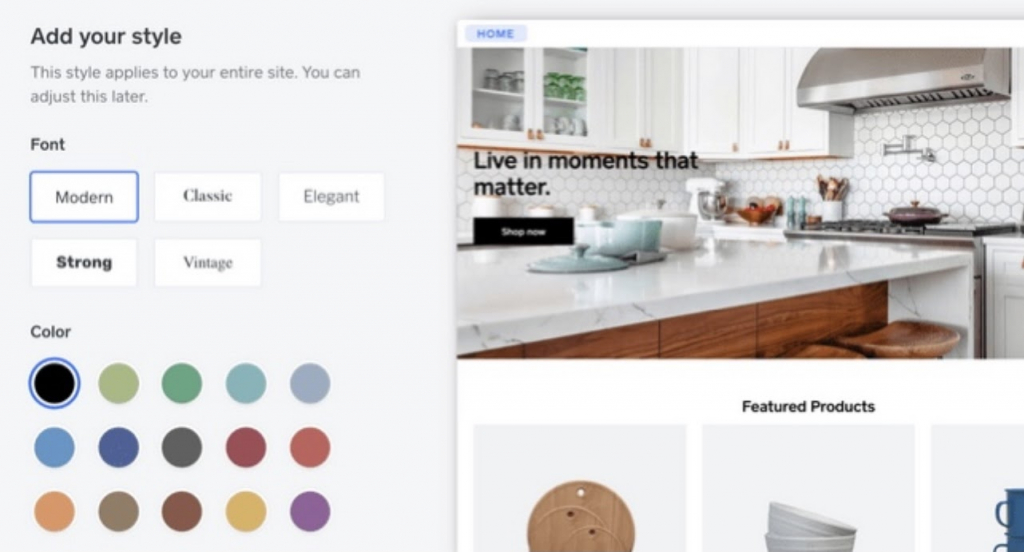
Shopify vs Square: Key Features
To better recognize the differences of the two platforms, let’s go into a detailed analysis of the features that Shopify and Square provide below.
Are you a merchant considering to build a Shopify B2B webstore? Then JUMP INTO Shopify B2B features to know if it meets your business demands.
Hosted Site
Shopify provides hosting for your site with unlimited bandwidth and unlimited products.
Square acquired website builder Weebly in 2018. Accordingly, Square uses Weebly’s software for its eCommerce websites. Square will provide you with an eCommerce website on its domain (with a $12 per month plan you can customize your own domain).
Themes/Templates
Shopify offers free and premium themes, so you’ll be sure to find one that best suits your business. Even after choosing a theme, a few additional styling options are available to give your website a unique look. In the dashboard, the fonts and colors for major web page elements can be changed with just a few clicks. More advanced users can go into customization detail every aspect of their website by accessing CSS and HTML files.
One of Shopify’s most impressive customization tools is the ability to create custom templates and then assign these templates to individual pages. Although this requires coding knowledge, it does allow an interface to be even further customized between pages.
Square differs from most online store building platforms because it has no themes to choose from. You will have to choose a starting point for your website instead of choosing a premade theme. Square allows you to do basic things like choosing a layout, font, and color when setting up your account.
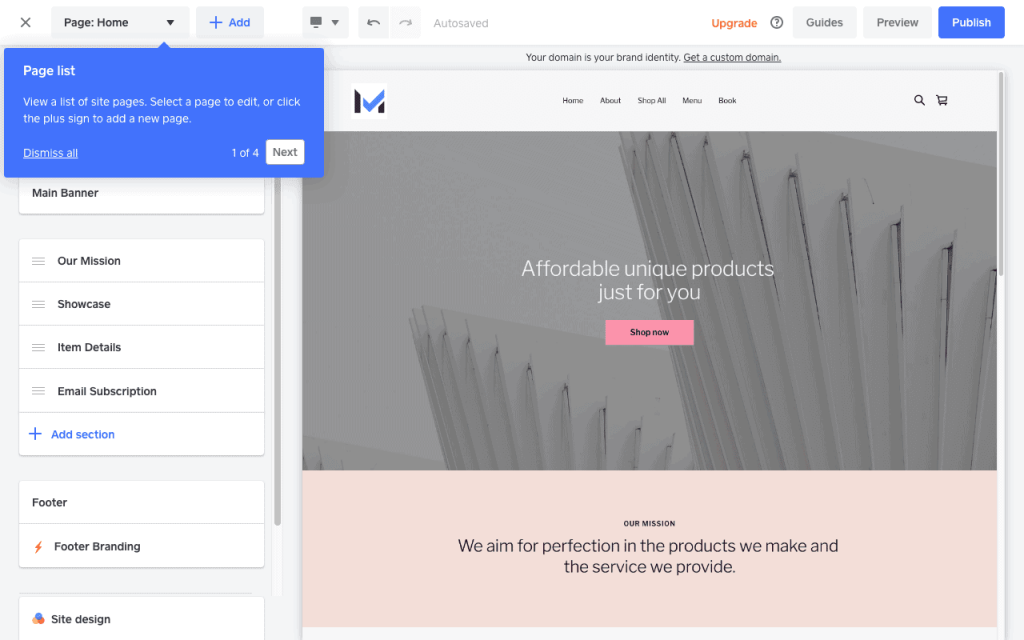
Square, on the other hand, has some limitations that you should keep in mind, such as you can only select a bunch of pre-made content blocks to add new content to your site. Furthermore, you must add an entire block instead of adding a text box to the web page. Square also does not provide any tools available for editing HTML or CSS. That means you can’t hire a web designer to adjust your website’s code, but have to do it in a design tool.
Products selling on Shopify and Square
Shopify allows you to handle both digital and physical products. They offer a free application that you can use to specify your product categories.
You can classify your products as digital and handle those specific deliveries via email, or as a downloadable product via online storage.
Square offers a lot of functionality when it comes to listing products. You can list a wide variety of products, including not only physical and digital products but also contributions, membership, services, event tickets or orders in progress. Alternatively, you can list multiple product variations (such as size and color) and allow customers to use modifiers. Display your items with multiple product images and get everything up and running quickly with bulk import and export features.
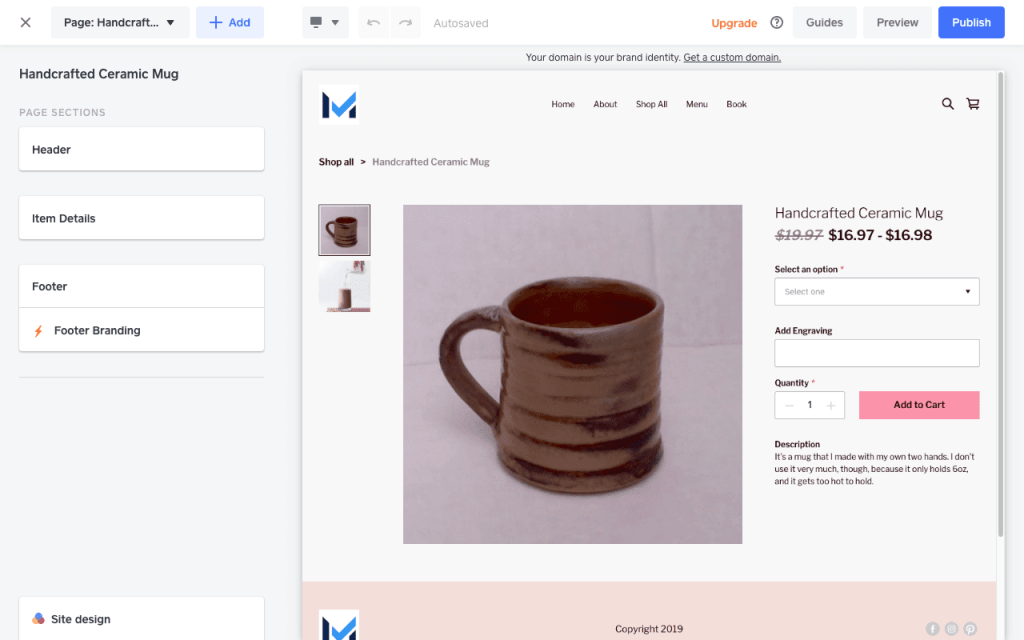
Multi-channel selling
Shopify focuses on the US market, so this platform supports connectivity with Amazon, eBay, Pinterest, Esty, Wanelo,… In addition to selling on the website and in the store, Shopify also allows you to sell your products on Facebook through Social Media Integration.
Square Online Store synchronizes with your Square POS system to enable omnichannel sales. The two systems work together to track your inventory as you sell, both online and in person. Customers’ online orders can be picked up at the store. Additionally, Square also provides other tools for creating password-protected pages, where B2B sellers can display their wholesale products to approved buyers.
Import/Export via CSV
Shopify and Square both easily import or export products and customer information using CSV files or update your inventory quantities in bulk. This also helps with moving stores.
Automatic Data Sync
With both platforms, inventory is automatically updated and synchronized across all of your sales channels, including your online store, your POS and social networks.
Shopify vs Square Reporting
With Shopify, depending on your plan, there are several types of analytics reports Shopify can create. These reports provide important insights into what products are selling (and which products are not), where visitors are coming from and how they found your online store, and integrate another information to create an effective marketing plan. Google Analytics is also easily integrated into your store.
Square does not provide professional and complex types of reports, but simply all the data you have available and can be downloaded from the Square dashboard. Square insights give you a look into your unique visits, page views, average pages per unique visit, and more.
Order and inventory management
Shopify offers comprehensive order management tools that work within apps as well as through dashboards. Besides, there are a variety of integrations to help with order management. Another great Shopify feature to recover missing sales by automatically emailing a pre-filled cart link and customized message to a customer who didn’t complete their purchase.
On the Inventory page of the Shopify admin page, you can view your inventory, adjust inventory, and create shipments. You can also view inventory adjustment history for in-stock products and models that are being tracked by Shopify. Plus, you can enable inventory tracking for products on the details page of the Shopify admin page.
With Square, your orders can be statistically managed through Square’s online dashboard, but not within the app. If you want to add additional lifting functions, you need to integrate with other extensions. Plus, Square recently launched new specially created features that help restaurants adapt during the COVID time. These features include a free ordering page, on-demand shipping, door-to-door delivery, and delivery options.
As for inventory management, you can track your inventory on your website along with in-store. Your inventory totals will be updated each time. However, you will have to manually adjust inventory levels to calculate profits, which is not convenient for store owners.
Shopify vs Square Payment Gateways
Payment gateways are indispensable to every online store, allowing them to make customer payments. It plays a key role in creating every customer’s eCommerce experience by allowing them to pay for your eCommerce store.
Shopify integrates more than 100 payment gateways to make it easy to sell products globally. Shopify supports two different types of payment solutions: its built-in payment engine called Shopify Payment and third-party payments. Shopify will waive the transaction fee for its payment provider. However, if Shopify payments are not available in your active regions, third-party payments will charge depending on your plan. Also, Shopify allows users to pay with virtual currency such as Bitcoin.
Instead of offering a full set of payment processing options, Square only gives you one option, Square’s payment processor. You can also add PayPal if you use advanced plans like Performance or Premium.
Shopify vs Square: POS
Shopify and Square are among the e-commerce platforms that you can also use for your physical storefront. This is a great resource for businesses that sell both online and in-store, as you will want a streamlined management system that takes all sales and operations into account.
With a starting point as a POS system, will Square surpass Shopify in this category? What are the advantages of these two platforms?

The features in Shopify’s and Square’s integrated POS systems are similar. When it comes to compatibility, both platforms work with Android and iOS, including tablets – especially with the iPad version.
Shopify POS and Square POS both offer features like inventory management, which can be tracked and synchronized in real-time across all stores. Also, the two support multiple payments, split tender, and tax charges. However, it can be said that thanks to custom payment options Shopify is more flexible than Square in this area.
Square, on the other hand, facilitated the credit card during outages, something Shopify couldn’t handle.
In general, while Shopify is more customizable, Square comes with more unique POS features. Both have their strengths and are extremely effective in supporting in-store sales.
Figure out more about Shopify vs BigCommerce
Shopify vs Square: Integrations & Add-Ons
If the features built into the plan aren’t enough for your online store, both Square and Shopify offer plenty of integrations with just about any feature you can think of.
Shopify allows you to access the app market to download other useful integrations and add-ons (free or paid) that bolster your store. The wide range of apps Shopify offers makes them one of the more flexible eCommerce platforms on the market.
You can expand your store with over 2,000 add-ons and more than 100 payment gateway. All of them are available from the Shopify app store to help you better manage various aspects of your online store like inventory, customers, shipping, marketing, and more.

On the other hand, Square integrates with around 150 add-ons and third-party software like accounting options, POS, invoicing, marketing, and more. While Square’s integrations are less than those of Shopify, it still provides the advanced features you need. Besides, Square integrates with Instagram, users who click on the product image on your Instagram account will be redirected to Square.
Also, Square can integrate with many other eCommerce software to process payments. Square also provides several APIs that help developers build custom add-ons.
Shopify vs Square: SEO & Marketing tools
SEO
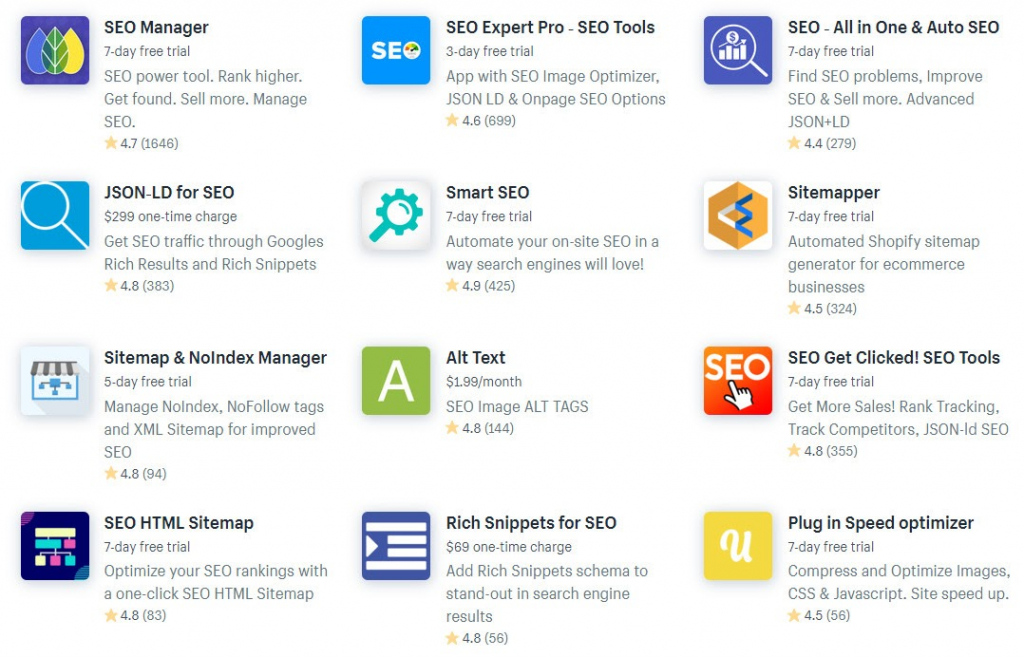
Shopify not only has code for easy and tidy crawl, but also allows you to insert custom tags and meta description tags. Shopify uses customizable H1, title, and meta tags for each page and product on your website. Alternatively, you can customize the preview as you want it to appear in search engine results.
Square provides a place for your product spelling out, just like for pages. Also, you cannot change much, nor does Square offer SEO solutions. Overall, Square’s SEO functionality is just enough for a small business. If you want to scale or optimize SEO even further, you’ll probably have to use 3rd party integration.
More of Shopify review: 6 Best SEO Apps for Shopify Site Optimization
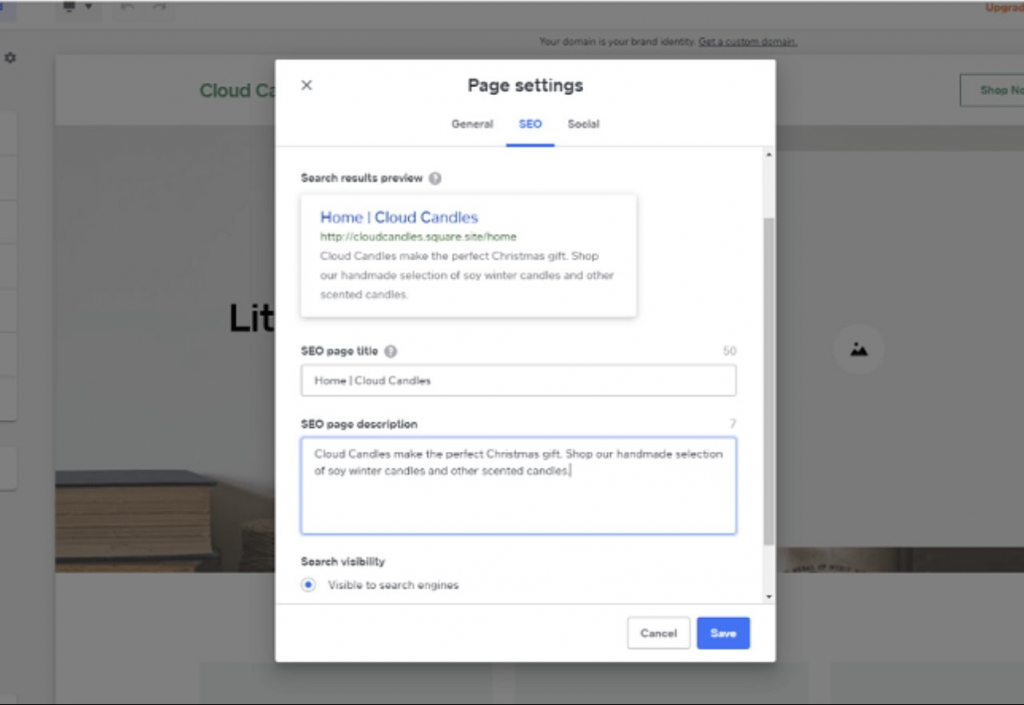
Pop-ups
Pop-ups can be a great way to advertise promotions and collect email signups. We actually use them a fair bit here on Website Builder Expert.
With Square, you can use pop-ups to:
- Collect emails
- Offer a coupon
- Make an announcement
- Verify age
Furthermore, Square’s pop-up window model has a beautiful and sophisticated design that helps customers not be annoyed when encountered. It’s also easy to quit and customize.

Email marketing has become a very effective selling tool on an online store. Today, most businesses use email marketing to reach powerful customers.
Shopify allows your customers to buy gift cards with whatever amount you have set up. Cards are generated with a unique code and sent to the customer instantly via email. Besides, the platform offers a solution to recover missing sales by automatically emailing abandoned cart links and customized messages to customers who have not completed their purchase.
Square automatically sends emails with the following forms:
- Order confirmation
- Items are shipped
- Items are refundable
- Items have been canceled
With Performance and Premium packages, you will have the added feature of abandoned cart email and encouraging customer reviews on the web. Plus, you can customize the email subject and content to match your branding.
Learn more about Shopify vs eBay
Shopify vs Square: Help and Support
Shopify
While Shopify is intuitive enough to get you started right away, there are a number of options available when you need help. Watch Shopify’s video tutorials or find quick answers by typing questions in the search field and scrolling through the results. Support is also available via chat (24/7), Twitter, email or phone.
Also, there are discussion forums and an “eCommerce University” with free tools and resources to help grow, launch, and build your business successfully.

Square
Square has made many customer service improvements. Square will answer your questions via phone, live chat and email. However, Square phone support is not available 24/7 and before you can make a call, you need to go through an online system to receive the code.
Besides, you can find help in the Square Online knowledge center, which houses about 180 articles on the most frequently asked topics.
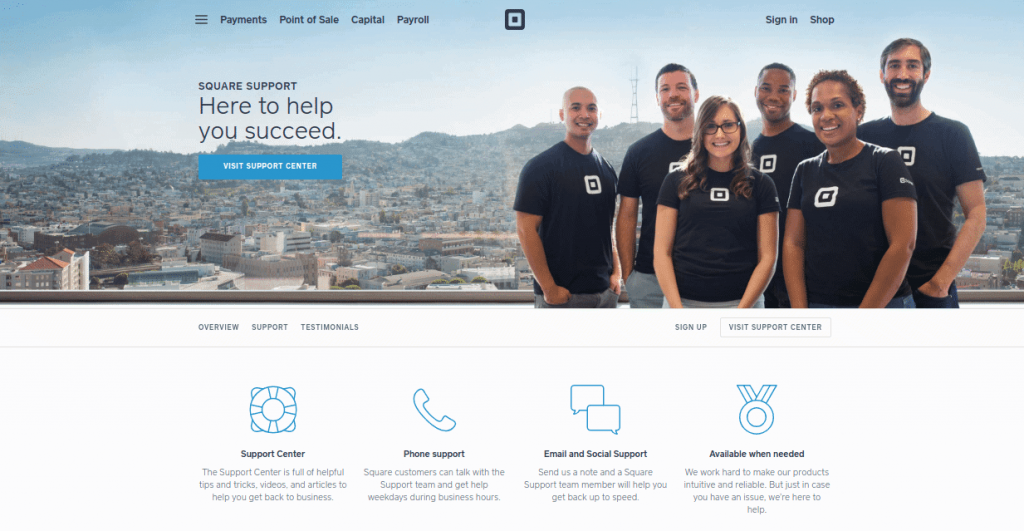
Shopify vs Square: which one is better?
It is difficult to argue that Shopify or Square is better, but both platforms have their own strengths. Choosing the right platform for your website depends on the features you are targeting. So we’ll give a brief summary of why you should choose Shopify and Square.
You should choose Shopify because:
- Provide unlimited bandwidth and items
- Offer a variety of templates
- Provide abandoned cart recovery
- Vast array of 3rd-party integrations
- There is an expert team to assist clients with advanced customization
- Inventory is coordinated by automatic data syncing processes
You should choose Square because:
- Host your site on its domain
- Provide automatic data syncing across the board
- Ability to integrate with other eCommerce platforms
- Provide an API that helps in setting up integrations on Square
If you are considering Shopify, let’s find out Top 10 Must-Have Shopify Apps for a New Store
Is Shopify better than Square? Shopify and Square each have their own advantages and disadvantages. BSS Commerce Shopify hopes this comparison helps you gain a better understanding of both platforms.





